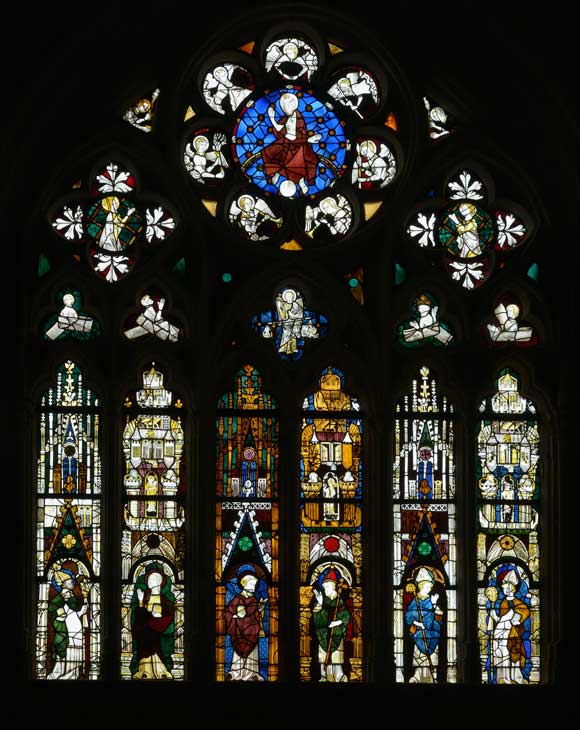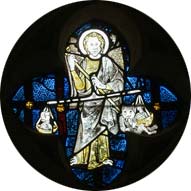By F.P,
with courtesy of Chartres Sanctuaire du Monde
In 2017, Chartres Sanctuaire du Monde devoted part of its sponsorship to the restoration of the stained glass windows in the Saint-Piat chapel, less well known than those in the nave and aisles, but nevertheless admirable.
After removal, they were sent to the master glassmakers selected by the DRAC following calls for tender.
These stained-glass windows, which bring to life several episodes from the Bible and great saints, including Saint Thecla, who was very popular in the Middle Ages, deserve a wide-ranging presentation.
Of particular interest is the large 14th-century flat chevet glass roof. The Resurrection of the Dead and the Last Judgment occupy the compartments of the tympanum, which features a seven-lobed rose.

Vitraux de la baie d’axe de la chapelle Saint-Piat, avant restauration
In the center, Christ sits as supreme judge; around him, five angels carry the instruments of the Passion, while two others sound the trumpet.
To his right and left, in the center of the quatrefoil, the Virgin Mary and Saint John the Evangelist intercede for human beings.
 Below, St. Michael weighs souls and, on either side, four small three-lobed openings depict the resurrection of the dead.
Below, St. Michael weighs souls and, on either side, four small three-lobed openings depict the resurrection of the dead.
At the bottom of the window, six lancets house saints, whose relics the cathedral possesses. They can be identified by inscriptions, from left to right: Saint Turiaf, bishop of Dol, Saint Thecla, Saint Piat, Saint Tugdual, bishop of Tréguier, and two anonymous bishops.
All these saints are surmounted by a large canopy adorned with motifs inspired by the architecture of the time. Religious architecture alternates with military architecture, a faithful record of drawbridges, machicolations, barbicans, bretches, watchtowers and crenellated towers topped by grotesque heads.
(Source: Y. Delaporte, Les vitraux de la chapelle Saint-Piat, MSAEL, t15,p33-58)
Saint Thecla

Sainte Thècle, détail
Saint Thecla was the first virgin martyr. She was converted after meeting St Paul on his first trip to Asia Minor in the middle of the 1st century. Overcome by Paul’s preaching in Iconium (Konia in modern-day Turkey), Thecla broke off her engagement, preferring Christ as her divine spouse. Condemned by the Roman governor, she survives six attempts on her life: fire, wild beasts, sea animals in a pool that give her the opportunity to baptize herself, believing her last hour to have come, and finally bulls destined to quarter her. She survived, accompanied Paul and then set off alone to teach the Christian faith, until her death at the age of 90 in Seleucia, Turkey.
An important pilgrimage developed, and numerous monasteries surrounded her sanctuary until around the 6th century.
Illustrious Fathers of the Church, such as St. Ambrose and St. Augustine, and numerous writings refer to Thecla as a model of feminine sanctity.
Very popular in Antiquity, her relics rested above the altar of holy bodies alongside other saints such as St. Piat and some of the earliest bishops of Chartres.
Today, almost forgotten in the West – with the exception of pilgrimages on her feast day on September 24: in Lozère and Brittany; in Spain at Tarragona, whose patron saint she is -, she remains venerated by Eastern Christians: 42 churches are dedicated to her in Lebanon.
Her shrine in Turkey is in ruins, and her tomb in a monastery in Syria at Ma’aloula was destroyed by war two years ago (update: in 2013). But this revered figure of a saint, a model of virginity, has inspired numerous works of art around the world: frescoes, paintings, sculptures, light bulbs, reliquaries and stained glass as in the chapel of Saint-Piat.
Original article published in the Lettre de Chartres Sanctuaire du Monde (february 2017)
photos : © Drac-Centre-Val-de-Loire – François Lauginie